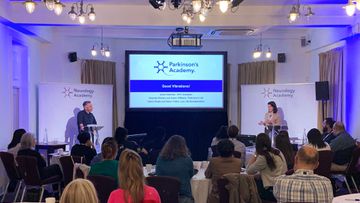Location location location! Place of death in Parkinson's disease
Event reportsOur seventh Parkinson's Cutting Edge Science conference took place on 19th March 2024 in Birmingham and was chaired by Prof Emily Henderson and Dr Neil Archibald. You can read an overview of the entire event here.
This write up is one of a series covering each session in detail for those who were unable to attend, or want to reflect on what they heard. Read more session write ups here.
New research shows that more people with Parkinson’s die at home than a decade ago, but there is still much more that could be done to give them their preferred place of death.
Presenting the data at this year’s Cutting Edge Science in Parkison’s Disease conference, Dr Elisabeth Wilson, Geriatric Medicine Registrar at North Bristol NHS Trust, said that the majority of people want to die at home.
A population-based study of place of death among people with long-term neurological conditions, however, found that just one in 10 of those with Parkinson’s died at home between 1993 and 2010. This was lower than in any of the other conditions investigated, including motor neuron disease and multiple sclerosis.[1]
Updating the evidence base
A lot have changed since then, including the advent of neuropalliative care, hospice at home services, and the COVID-19 pandemic, said Dr Wilson. “We wanted to see if this had changed anything,” she added.
Her team’s project, which was published in Age and Aging in March 2024, aimed to describe the trends in place of death for people with PD before, during, and after COVID, identify regional trends, and analyse the experience of people living with co-existing dementia.[2]
Using Office of National Statistics data on all 2,415,566 adult deaths between March 2018 and July 2022 in England and Wales, they compared the place of death of people with PD and related disorders (PDRD) and people with PDRD and dementia to all other adults.[2]
They found that home deaths had almost doubled, from 9.7% in the earlier study to 19.19%, among people with Parkinson’s. Hospice deaths among this group also increased, from 0.6% between 1993 and 2010 to 2.03% from 2018 and 2022. A sub-analysis of people with PDRD and co-existing dementia revealed that 51.57% died in a care home, 15.28% at home, and 31.27% in hospital.[2]
While the number of people with Parkinson’s dying at home has increased dramatically, the majority, 44.14% still died in hospital. Advanced care planning, Dr Wilson said, has been shown to improve the likelihood of people being given their preferred place of death.[3]
The study also found that during the first wave of COVID-19, there was a spike in the proportion of deaths occurring in care homes and a corresponding drop in hospital deaths, while the opposite trend was observed during the second wave. From March 2020, Dr Wilson went on, there was an increase in home deaths both among the general population and people with PDRD.[2]
There was also a fall in care home deaths among people with PDRD that was not reflected in the general population. The trends were recorded in most areas of the UK, though London was a “slight outlier”, with fewer care home deaths. “London has fewer care home beds per population, and the second fewest nursing home beds in the country,” said Dr Wilson, “People with Parkinson’s in London have less ability to choose where they would prefer to die, meaning they are more likely to die in hospitals.”

Facilitating a better death
It's important to know where people Parkinson's disease die, said Dr Wilson. “It is helpful in terms of service planning: making sure people have access to palliative care specialists and Parkinson's disease at the end of life,” she added.
Advanced care planning and evidence-based service design are key to facilitating a better death. For healthcare professionals, that means documenting their patients’ wishes as well as working within the wider system to ensure everyone has access to the care they need.
“This is a group of people with a high symptom burden at end of life,” said Dr Wilson, citing high levels of agitation, pain, and respiratory secretions. “We know that the place of death for people with Parkinson's disease is changing, and we need to advocate for them,” said Dr Wilson. With people with PDRD and co-existing dementia being more likely to die in care homes, for example “we need to make sure our Parkinson's and palliative care services are reaching those people”.
Further research
Moving on to talk about next steps, Dr Wilson said her team now hoped to investigate ongoing trends, and map place of death to regional hospice availability, including community services and inpatient beds. They also plan to look at the cost-effectiveness of resourcing community teams to provide people with PDRD with end of life care.
“We only have one chance to get this right,” she said.
References:
Sleeman, K. E., Ho, Y. K. et al. (2013). Place of death, and its relation with underlying cause of death, in Parkinson’s disease, motor neurone disease, and multiple sclerosis: a population-based study. Palliative Medicine, 27(9), 840-846.
Wilson, E., Baker, A., et al. (2024). Place of death in Parkinson’s disease and related disorders in England and Wales: post-pandemic trends and implications for care planning. Age and Ageing, 53(3), afae048.
Dixon, J., King, D., et al. (2019). Advance care planning in England: Is there an association with place of death? Secondary analysis of data from the National Survey of Bereaved People. BMJ supportive & palliative care, 9(3), 316-325.

This meeting is designed and delivered by the Parkinson’s Academy and sponsored by BIAL Pharma. The sponsor has had no input into the educational content of this meeting.
Related articles
'The things you can't get from the books'
Parkinson's Academy, our original and longest running Academy, houses 23 years of inspirational projects, resources, and evidence for improving outcomes for people with Parkinson's. The Academy has a truly collegiate feel and prides itself on delivering 'the things you can't get from books' - a practical learning model which inspires all Neurology Academy courses.








